
All categories
Featured selections
Trade Assurance
Buyer Central
Help Center
Get the app
Become a supplier

(6733 products available)

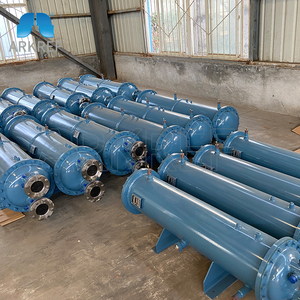

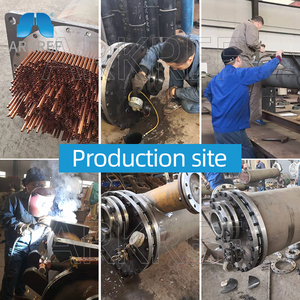











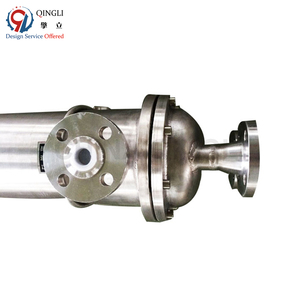

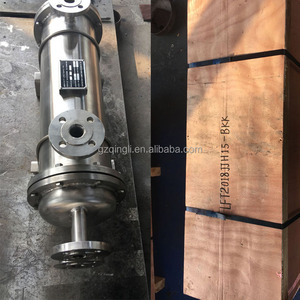


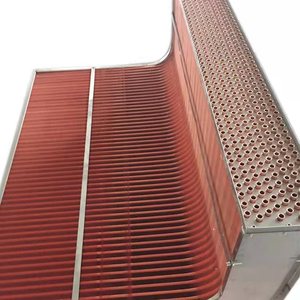


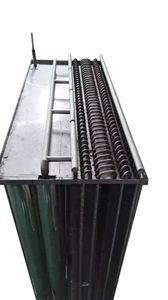


Functional condenser cooling machines, shell, and tube condensers come in various types that allow them to perform their functions and be efficient.
Some key shell and tube condenser specifications are as follows:
Size
Shell and tube condensers are available in various lengths, diameters, and tube counts to suit specific industrial applications. For example, there can be tube bundles with 50 to 5000 tubes, tube diameters from 3/8 to 1 inch, and shell diameters up to 60 inches.
Materials
The main components of a shell and tube condenser are the tubes, tube sheets, shells, and end covers. They may be manufactured using carbon steel, stainless steel, or other corrosion-resistant alloys, such as Cu-Ni, depending on the fluid and pressure requirements. For example, copper is a common material for condenser tubes because of its superior thermal conductivity and anti-corrosion properties.
Temperature and Pressure Ratings
A shell and tube condenser's efficiency relies on its capacity to withstand the heat exchange caused by varying temperatures. The temperature and pressure limits specify operational ranges to prevent mechanical failure, leakage, and safety hazards. The temperature and pressure ratings vary greatly depending on the design and component materials. For example, some tubes can have a temperature limit of 200°C at an 8-bar pressure.
Number of Passes
A shell and tube condenser can be one-pass or multi-pass. It means that the cooling fluid can flow through the tube system once or several times, depending on the design and configuration of the baffles.
Shell and tube condensers need regular maintenance and repair in the following ways:
Inspection and Cleaning
Before starting the machine, visually inspect the inside and outside of the condenser for any damages or leaks in the tubes or shell. Look at the tube bundle to see if there is any fouling that needs to be cleaned immediately. After use, open the inspection door to clean the shell interior and check the parts that can be accessed easily. Only a qualified and trained operator should perform this task.
Leak Checking
Operators should look carefully at the joint areas of the tube sheets and the shell on both sides. They should also check the tube bundles' integrity to ensure there are no leaks. If they find any leaks, they should carry out immediate repairs. They can use leak detection chemicals and dye penetrants to locate the leaking areas. They can proceed to use the manual or automatic tube leak detector to locate and fix the leaks as soon as possible.
Fouling Removal
Over time, dirt and deposits can accumulate inside the tubing, which is called 'fouling.' This may reduce thermal conductivity and lead to higher energy costs. Doing chemical cleaning or hydraulic cleaning as per the fouling type and location can prevent this problem. Ordinarily, the cleaning process uses a combination of chemicals, such ion exchange, to remove the fouling. An expert in this process can determine the type of fouling and recommend treatment.
Shell and tube condensers are widely used industrial equipment in various sectors.
Heat recovery in energy generation
In power plants, especially the thermal and nuclear ones, shell and tube condensers are used to cool and condense the steam coming from the turbine back to the water for the cycle repeat. They play an important role in improving the efficiency of the power plant by recovering heat.
Cooling in chemical processing
Shell and tube condensers are commonly used in chemical plants. They are used to cool reaction products or vapors and condense the vapors of solvents to save resources and reduce emissions.
Oil refineries and fractionation
In oil refineries, shell and tube condensers are used in units such as distillation, cracking, and extraction to condensate the vaporization of the oil. They are key devices which can control product separation and improve the yield.
HVAC and refrigeration
In the refrigeration and air conditioning industries, shell and tube condensers are used as external heat exchangers to dissipate heat generated in the system to the external environment. They help cool refrigerants to complete the cycle.
Pharmaceutical manufacturing
Shell and tube condensers are extensively used in the pharmaceuticals industry. They are applied to processes such as crystallization, extraction, and reaction to cool or condense. They ensure product quality and process stability.
Food processing
In the food processing industry, shell and tube condensers are used in units like evaporators and extractors to reclaim and condense the vaporized materials. They are pivotal in concentration and extraction processes, contributing to resource efficiency and food safety.
Environmental protection and waste treatment
In sewage treatment and environmental protection facilities, shell and tube condensers are applied to treat and recover resources from wastewater. They help protect the environment by preventing pollution.
Consider the following factors to select the suitable tube shell condenser for a facility's needs:
Process requirements:
Evaluate the fluid to be processed. This includes the fluid's flow rate, temperature ranges for incoming and desired outlet temperatures, pressure levels, and the presence of any particular characteristics, such as corrosive or hazardous properties. In addition, determine relevant heat transfer requirements, such as heat transfer coefficients and whether there are constraints for the equipment installation space.
Transfer efficiency:
Modern condenser designs improve heat transfer efficiency. Enhanced-performance shell-and-tube condensers with helical baffles or segmented baffles reduce fluid flow stagnation regions and increase fluid mixing. Selection of the ideal shell-and-tube condenser for a particular process will require consideration of the heat transfer efficiency of different available models.
Resistance to fouling:
Fouling affects thermal conductivity by reducing heat transfer. Regular cleaning is necessary to maintain optimal system performance. Consider cleaning frequency, time, and process when choosing the condenser. Select the condenser model that will support the cleaning process, thereby minimizing downtime and maintaining system efficiency.
Cost:
Consider the initial investment and operating costs over the equipment's life cycle. Evaluate the condenser's energy consumption and maintenance expenses, the availability of spare parts, and worldwide support services.
Code Compliance:
Ensure the condenser complies with relevant codes and standards, including environmental regulations. This consideration is particularly important for condensers used in refrigeration, HVAC, and chemical processes that must comply with specific environmental requirements and safety standards.
Supplier support:
Consider the technical support and consulting services offered by suppliers. These include engineering analysis, system optimization, and project management during the design and implementation phases. Also, assess the supplier's training programs and resources to ensure adequate staff training and the safe and efficient operation of the equipment.
Q1 Where do people use shell and tube condensers?
A1 In industrial settings like chemical factories, power plants, and refineries where they're making chemicals or processing oil, condensers are a must. They cool off gases into liquids. Because they're so reliable, condensers also last for a long time. That's why you'll find them in sprawling factory complexes and bigger facilities. The same goes for power plants that turn fossil fuels into electricity.
Q2 What are the latest trends in shell and tube condensers?
A2 Because energy conservation is so important these days, more and more shell and tube condensers are being made with smarter cooling methods that save energy. Some condensers now have heat recovery systems that take leftover heat from a process and use it to cool something else, which is a great way to save energy. Adaptable, flexible condensers that can change based on how much they're processing at different times are becoming more common too. This helps businesses save costs. Remote monitoring is another trend. Businesses can now keep an eye on the performance of their condensers from far away using condensers that have smart sensors and controls. This lets them do maintenance before things go wrong, which helps avoid downtime and keeps productivity up. Shell and tube condensers are evolving with the times by becoming more energy-efficient, adaptable, and technically advanced, thus meeting modern industry needs better.
Q3 Do shell and tube condensers require a lot of maintenance?
A3 Like any piece of machinery, shell and tube condensers need regular upkeep to keep working well. But the good news is the maintenance requirements aren't that high. If operators pay attention and stick to the schedule of inspections and cleaning, their condensers will always remain in good shape and last a long time. The schedule is pretty simple: just take a look at the condensers now and then and do some basic cleaning. That's really all there is to it.
Q4 What is the future of shell and tube condensers?
A4 Shell and tube condensers have a bright future ahead. They're still the workhorses of cooling systems in industries worldwide. The technology keeps evolving. New designs are coming out that save energy and protect the environment. Innovations like smarter controls and better materials will make them more efficient and durable. These developments are meeting the needs of modern industries. Shell and tube condensers will continue to play a crucial role in process industries like oil, chemicals, power generation, and more. They have an important part to play in cooling gases and recycling heat. The condensers will adapt to industry demands. They will get upgraded with new technologies to keep supporting industrial production sustainably.